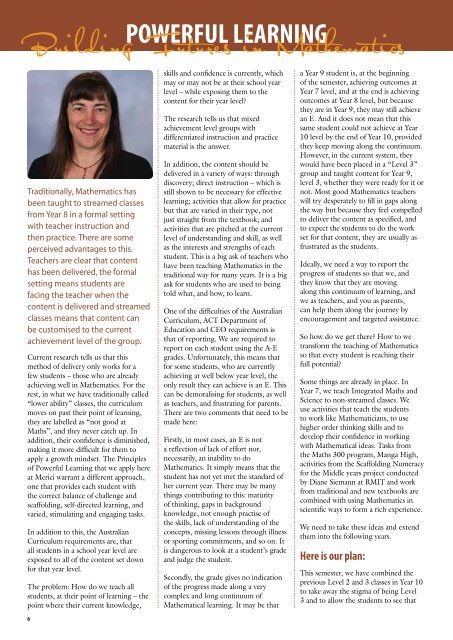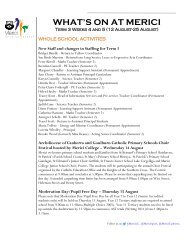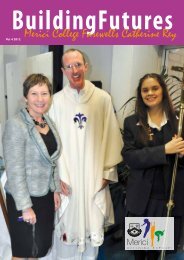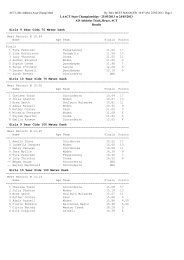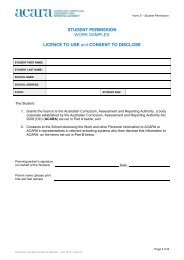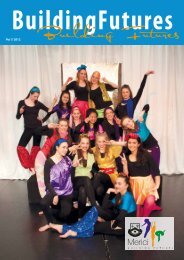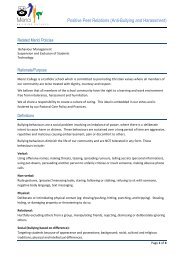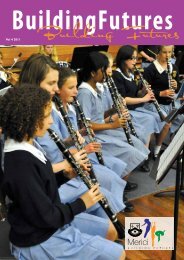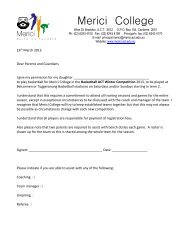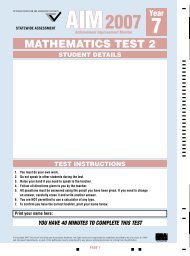Building Futures Vol 6 2012.pdf - Merici College
Building Futures Vol 6 2012.pdf - Merici College
Building Futures Vol 6 2012.pdf - Merici College
Create successful ePaper yourself
Turn your PDF publications into a flip-book with our unique Google optimized e-Paper software.
POWERFUL LEARNING<strong>Building</strong> <strong>Futures</strong> in MathematicsTraditionally, Mathematics hasbeen taught to streamed classesfrom Year 8 in a formal settingwith teacher instruction andthen practice. There are someperceived advantages to this.Teachers are clear that contenthas been delivered, the formalsetting means students arefacing the teacher when thecontent is delivered and streamedclasses means that content canbe customised to the currentachievement level of the group.Current research tells us that thismethod of delivery only works for afew students – those who are alreadyachieving well in Mathematics. For therest, in what we have traditionally called“lower ability” classes, the curriculummoves on past their point of learning,they are labelled as “not good atMaths”, and they never catch up. Inaddition, their confidence is diminished,making it more difficult for them toapply a growth mindset. The Principlesof Powerful Learning that we apply hereat <strong>Merici</strong> warrant a different approach,one that provides each student withthe correct balance of challenge andscaffolding, self-directed learning, andvaried, stimulating and engaging tasks.In addition to this, the AustralianCurriculum requirements are, thatall students in a school year level areexposed to all of the content set downfor that year level.The problem: How do we teach allstudents, at their point of learning – thepoint where their current knowledge,6skills and confidence is currently, whichmay or may not be at their school yearlevel – while exposing them to thecontent for their year level?The research tells us that mixedachievement level groups withdifferentiated instruction and practicematerial is the answer.In addition, the content should bedelivered in a variety of ways: throughdiscovery; direct instruction – which isstill shown to be necessary for effectivelearning; activities that allow for practicebut that are varied in their type, notjust straight from the textbook; andactivities that are pitched at the currentlevel of understanding and skill, as wellas the interests and strengths of eachstudent. This is a big ask of teachers whohave been teaching Mathematics in thetraditional way for many years. It is a bigask for students who are used to beingtold what, and how, to learn.One of the difficulties of the AustralianCurriculum, ACT Department ofEducation and CEO requirements isthat of reporting. We are required toreport on each student using the A-Egrades. Unfortunately, this means thatfor some students, who are currentlyachieving at well below year level, theonly result they can achieve is an E. Thiscan be demoralising for students, as wellas teachers, and frustrating for parents.There are two comments that need to bemade here:Firstly, in most cases, an E is nota reflection of lack of effort nor,necessarily, an inability to doMathematics. It simply means that thestudent has not yet met the standard ofher current year. There may be manythings contributing to this: maturityof thinking, gaps in backgroundknowledge, not enough practise ofthe skills, lack of understanding of theconcepts, missing lessons through illnessor sporting commitments, and so on. Itis dangerous to look at a student’s gradeand judge the student.Secondly, the grade gives no indicationof the progress made along a verycomplex and long continuum ofMathematical learning. It may be thata Year 9 student is, at the beginningof the semester, achieving outcomes atYear 7 level, and at the end is achievingoutcomes at Year 8 level, but becausethey are in Year 9, they may still achievean E. And it does not mean that thissame student could not achieve at Year10 level by the end of Year 10, providedthey keep moving along the continuum.However, in the current system, theywould have been placed in a “Level 3”group and taught content for Year 9,level 3, whether they were ready for it ornot. Most good Mathematics teacherswill try desperately to fill in gaps alongthe way but because they feel compelledto deliver the content as specified, andto expect the students to do the workset for that content, they are usually asfrustrated as the students.Ideally, we need a way to report theprogress of students so that we, andthey know that they are movingalong this continuum of learning, andwe as teachers, and you as parents,can help them along the journey byencouragement and targeted assistance.So how do we get there? How to wetransform the teaching of Mathematicsso that every student is reaching theirfull potential?Some things are already in place. InYear 7, we teach Integrated Maths andScience to non-streamed classes. Weuse activities that teach the studentsto work like Mathematicians, to usehigher order thinking skills and todevelop their confidence in workingwith Mathematical ideas. Tasks fromthe Maths 300 program, Manga High,activities from the Scaffolding Numeracyfor the Middle years project conductedby Diane Siemann at RMIT and workfrom traditional and new textbooks arecombined with using Mathematics inscientific ways to form a rich experience.We need to take these ideas and extendthem into the following years.Here is our plan:This semester, we have combined theprevious Level 2 and 3 classes in Year 10to take away the stigma of being Level3 and to allow the students to see that


